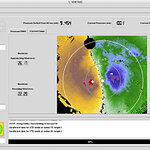Atmospheric

The biggest blow-up in the science community about Al Gore's "An Inconvenient Truth" was not over the 20 foot ocean rises but the images of Hurricane Katrina and the implication that global warming had a hand in it.
Scientists at the Carnegie Institution say there may be something to it, though indirectly.
The Earth’s jet streams, the high-altitude bands of fast winds that strongly influence the paths of storms and other weather systems, are shifting — it could be argued that is in response to global warming.
The Carnegie scientists determined that over a 23-year span from 1979 to 2001 the…

A new study shows that wetland regions emitted significantly less methane during glacial times while methane emissions by forest fire activity remained surprisingly constant from glacial to interglacial times.
Using novel isotopic studies, scientists from the European Project for Ice Coring In Antarctica (EPICA) say this identifies the most important processes responsible for changes in natural methane concentrations over the transition from the last ice age into our warm period.
Ice cores are essential for climate research because they represent the only archive which allows direct…

A team of European scientists has triggered electrical activity in thunderclouds for the first time - deliberately.
They did it by aiming high-power pulses of laser light into a thunderstorm. Next, they say, could be man-made lightning.
At the top of South Baldy Peak in New Mexico during two passing thunderstorms, the researchers used laser pulses to create plasma filaments that could conduct electricity akin to Benjamin Franklin's silk kite string. No air-to-ground lightning was triggered because the filaments were too short-lived, but the laser pulses generated discharges in the…

A new technique that helps forecasters continuously monitor landfalling hurricanes, giving them frequent and detailed images of a storm's location, will be implemented this summer.
The new system, developed by researchers at the National Center for Atmospheric Research (NCAR) in Boulder, Colo., and the Naval Research Laboratory (NRL) in Washington, D.C., will be implemented at the National Hurricane Center (NHC).
The technique, known as VORTRAC (Vortex Objective Radar Tracking and Circulation), was successfully tested by the hurricane center last year. The system, which relies on existing…

Research published in the Institute of Physics' Environmental Research Letters shows how a team from Lancaster and Durham Universities sought a means to prove the correlation between the ionizing cosmic rays and the production of low cloud cover.
Previous research had shown a possible correlation, using the results of the International Satellite Cloud Climatology Project, and this had been used to propose that global warming was due to cosmic rays.
The new research shows that change in cloud cover over the Earth does not correlate to changes in cosmic ray intensity. Neither does it show…

Nitrous oxide, laughing gas, can't get any respect. Unlike carbon dioxide and methane, laughing gas has been largely ignored by world leaders as a worrying greenhouse gas but nitrous oxide must be taken more seriously, said Professor David Richardson from the University of East Anglia at the Society for General Microbiology’s 162nd meeting this week.
The potent gas is mainly coming from waste treatment plants and agriculture. Its release is increasing at the rate of 50 parts per billion or 0.25% every year. This means that it can be better controlled with suitable management strategies, but…

Chemists at the University of California, San Diego have discovered that a chemical reaction in the atmosphere above major cities long assumed to be unimportant in urban air pollution is in fact a significant contributor to urban ozone—the main component of smog.
Their finding should help air quality experts devise better strategies to reduce ozone for US areas that exceed new standards announced last week by the Environmental Protection Agency and also benefit cities like Mexico City and Beijing that are grappling with major air quality and urban smog problems. More than 100 million people…

The Arctic - pristine natural wilderness, unmolested by human touch? Not really. While early explorers claimed they could see 200 KM mountain peaks that certainly isn't the case today. In winter months, the Arctic actually has some of the dirtiest air in the world. It turns out even those early explorers may have been romanticizing the cleanliness a bit.
Scientists know that air pollution particles from mid-latitude cities migrate to the Arctic and form an ugly haze, but a new University of Utah study finds surprising evidence that polar explorers saw the same phenomenon as early as 1870…

While significant gaps remain in our total knowledge of the extent of carbon dioxide’s sources, such as fires, volcanic activity and the respiration of living organisms, and its natural sinks, such as the land and ocean, it is known that more than 30 billion tons of extra carbon dioxide (CO2) is released into the atmosphere annually by human activities, mainly through the burning of fossil fuels.
According to the latest report by the Intergovernmental Panel on Climate Change (IPCC), this increase is predicted to result in a warmer climate with rising sea levels and an increase of extreme…

The growth in China's carbon dioxide (CO2) emissions is far outpacing previous estimates, making the goal of stabilizing atmospheric greenhouse gases much more difficult, according to a new analysis by economists at the University of California, Berkeley, and UC San Diego.
Previous estimates, including those used by the Intergovernmental Panel on Climate Change, say the region that includes China will see a 2.5 to 5 percent annual increase in CO2 emissions, the largest contributor to atmospheric greenhouse gases, between 2004 and 2010. The new UC analysis puts that annual growth rate for…